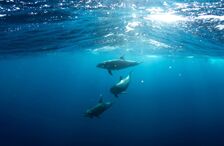世界海洋日:盘点那些清理海洋的奇妙发明
|
今天是世界海洋日。 2008年12月5日第63届联合国大会通过第111号决议,决定自2009年起,每年的6月8日为“世界海洋日(World Oceans Day)”。 2019年世界海洋日的主题是“性别与海洋(gender and oceans)”。 现在海洋污染已经非常严重,你不用潜到海里就可以看见海面上漂浮的成堆的垃圾,而且这些垃圾还在不断增加。 幸好,我们的地球上还有一些人在设法清理海洋垃圾,还发明了各种高科技的“海洋清理神器”,来看看它们都有什么本领吧。
The Seabin project Invented by two Aussie surfers, the Seabin is pretty much exactly what you think: it’s a large flowerpot-shaped container that captures everything from plastic bottles, bags and utensils, as well as trash as small as 2mm. A pump at the bottom of the bin sucks in water and rubbish, which are then separated by a mesh unit inside. The water is then released, while the trash is recycled. 由两名澳洲冲浪者发明的海上垃圾桶Seabin和你猜想的差不多:它是一个花盆状的大容器,可以捕获塑料瓶、塑料袋和各种用具,包括2毫米那么小的垃圾。垃圾桶底部的泵可以吸进水和垃圾,内部的网面会将它们分离。水被放掉,垃圾被回收。 The seabins are fitted around marinas and coasts, trapping rubbish before it can make its way into the ocean proper. According to the Seabin website, each bin can catch 90,000 plastic bags a year, nearly 36,000 disposable cups, 16,500 plastic bottles and 166,500 plastic utensils. There are over 700 Seabins located around the world, with many concentrated along the coasts of European countries. 海上垃圾桶被安装在码头和海岸周围,在垃圾进入内海之前就把垃圾截住。据Seabin官网介绍,每个垃圾桶每年可以捕获9万个塑料袋、近3.6万个一次性杯子、16500个塑料瓶和166500个塑料用具。世界各地共有700多个海上垃圾桶,许多都集中在欧洲国家的海岸沿线。 marina[mə'rinə]: n. 码头
Recycling Technologies Capturing plastic in the oceans is one thing, but what to do with it once it’s back on land? According to the UN, less than one tenth of plastic produced gets recycled. However, one UK company has come up with an ingenious way of dealing with types of plastic that are ‘unrecyclable’— before they even make it into our waters. 捕获海洋垃圾是一回事,但垃圾上岸后要怎么处理它们呢?根据联合国的数据,得到回收的塑料产品还不到十分之一。但是,一家英国公司想出了一种巧妙的办法来处理“不可回收”的塑料,甚至是在这些塑料进入海洋之前。 Rather than let many types of plastic get sent to landfills, be incinerated or exported, Recycling Technologies has come up with another solution: melt it, and then turn it into an oil that can then be turned into everything from new packaging to wax for waterproofing, product surface coating and more. “回收技术”公司不是将多种垃圾送去垃圾填埋场、焚烧或出口,而是想出了另一种解决办法:将垃圾熔化提炼出一种油,并用这种油做成新包装、防水蜡、产品表面涂层等各种产品。 incinerate[ɪn'sɪnəreɪt]: vt. 焚化;烧成灰 Plastic-eating enzyme An innovation that has a profound impact on plastic was created completely by accident. Back in April 2018, scientists announced that they inadvertently created an enzyme called PETase that can break polyethylene terephthalate (PET) plastics down to its original chemicals. 这项对塑料产生深远影响的创新技术的出现完全是偶然。2018年4月,科学家宣布无意间创造出了一种名为PETase的酶,这种酶可以把聚对苯二甲酸乙二醇酯(PET)塑料分解成原始的化学物质。 inadvertently['ɪnəd'vɝtntli]: adv. 无意地,不经意地 enzyme['ɛnzaɪm]: n. [生化] 酶 This is seen as a breakthrough because PET, which is used to make packaging by the food and drink industry, is extremely hard to break down into a state that would allow it to be recycled into other high-quality plastic products, instead coming out as a lower-grade and therefore less-valuable product. This means that new high-quality plastic packaging still has to be made. 这被视为突破性进展,因为用于食品和饮料包装的PET极其难分解,无法经过回收重新制成高质量塑料产品,只能制成低价值的低级产品。这意味着还要用新原料来制作高质量的塑料包装。 However, with the discovery of PETase, it is hoped the recycling loop can be closed so that old PET products get recycled into products of the same high-quality. 然而,随着PETase被发现,塑料包装有望实现循环回收利用,旧的PET产品将能经过回收被重新制成同样高质量的产品。 WasteShark Referred to as the ‘Wall-E of the water’ the WasteShark is an aquadrone that sucks up garbage from the water. 绰号“水中瓦力”的垃圾鲨鱼是从海水中吸走垃圾的水下无人机。 Created by RanMarine, a Dutch environmental technology company, the WasteShark was initially deployed in the Dubai Marina. It can swim for up to 16 hours and consume as much as 1,100lbs of trash. 荷兰环保技术公司RanMarine制造的垃圾鲨鱼最初被用于迪拜码头。垃圾鲨鱼可以持续游16个小时,吃进多达1100磅(约500千克)的垃圾。 It collects everything from floating trash, plastic and even microplastic. It has sensors that measure everything from pH, nitrate, water salinity and chloride. Once the trash is collected, the aquadrone delivers it to the collection point. 垃圾鲨鱼可以收集从漂浮物到塑料的各种垃圾,甚至可以吸进塑料微粒。它的传感器可以测量酸碱度、硝酸盐、盐度、氯化物等各种指标。一旦垃圾装满,水下无人机就会把垃圾送到收集点。 PlanetCare’s washing machine filter PlanetCare approaches the issue of ocean pollution from a different angle. Rather than dealing with the plastic pollution that has already made it out into the open water, the Slovenian company designed a product that tackles it at source. PlanetCare公司从一个不同的角度来应对海洋垃圾问题。这家斯洛维尼亚公司不是处理已经进入海洋的塑料垃圾,而是设计出一个从源头控制污染的产品。 The company’s focus is microfibres on items of clothing such as fleeces. These strands, as small as 0.5mm are too small to be captured by machine wash filters, and ultimately make their way into the ocean, where they are mistaken for food by marine life. The fish can then suffocate on the fibers which can also attract toxins. 这家公司专注于对付绒毛这种衣物上的微纤维。这些只有0.5毫米大小的微纤维无法被洗衣机的过滤网捕获,最终会进入海洋,被海洋生物误认为食物。这些微纤维会导致鱼类窒息,还会吸收毒素。 PlanetCare has created a special washing machine filter that is designed to capture the fibres shed from clothes during washes, which can add up to as many as 700,000 per average 6kg wash. PlanetCare公司发明出一种特别的洗衣机过滤网,旨在捕获衣物清洗过程中掉落的微纤维。6千克衣物在清洗过程中掉落的微纤维平均可达70万个。 |









